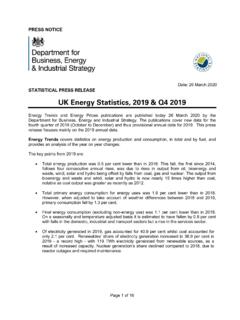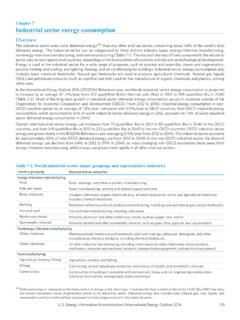Transcription of By sector. By fuel.
1 Responsible statistician: Liz Waters Email: Media enquiries: 0207 215 1000 Public enquiries: 0207 215 5000 Next publication: 29 July 2021 energy consumption in the UK (ECUK) 1970 to 2019 22 October 2020 National Statistics total energy consumption in the UK decreased by million tonnes of oil equivalent (mtoe) (or per cent) between 2018 and 2019 to mtoe. All sectors saw a fall in consumption with almost half of the total decrease (45 per cent) being accounted for by the industrial sector with a further quarter by the domestic sector. With the exception of bioenergy and waste, all fuels saw a decrease particularly petroleum which fell by mtoe ( per cent).
2 Bioenergy consumption increased by mtoe ( per cent) with three quarters of the increase being liquid biofuels consumed in transport offsetting to some extent the fall in petroleum in that sector. Overall, transport consumption fell by just per cent. The energy ratio fell by per cent (Table I1), meaning that increased efficiencies reduced the amount of energy needed to underpin each unit of Gross Domestic Product (GDP, 1 million). Figure 1 below shows the long-term trends in consumption by sector and fuel; by sector, the most notable element is the growth in transport consumption and fall in industrial. By fuel, coal has fallen considerably since 1970 (by 96 per cent) with gas consumption more than tripling (though has since fallen by a quarter since consumption peaked in 2001).
3 Figure 1: Change in energy consumption by sector and fuel 1970 to 2019 By sector. By fuel. Responsible statistician: Liz Waters Email: Media enquiries: 0207 215 1000 Public enquiries: 0207 215 5000 Next publication: 29 July 2021 What you need to know about these statistics: energy consumption in the UK (ECUK) is an annual publication that covers final energy consumption . It is of interest to a wide range of users including academics, energy industry experts, government policy users, and members of the public. These statistics provide additional insights and analysis of final energy consumption to complement the Digest of UK energy Statistics (DUKES), which focuses on detailed energy An interactive tool is published alongside this document which enables users to create and download charts and data tables on consumption according to interests and level of detail required.
4 The tool will be updated for 2019 data on 29th October. Additionally, the Excel data tables also contain methodology notes and supporting information along with additional charts enabling users to see all relevant information in one place. consumption data are mostly sourced from DUKES and are of good quality. However, some of the modelled tables are based on research undertaken only periodically and have not been updated for some time. This is particularly relevant for end uses in the industrial sector but in the interest of providing a comprehensive picture of detailed consumption patterns, proportions obtained from historical modelling have been applied to updated consumption totals from DUKES.
5 The proportions applied have now been included in the Excel tables marked as reference tables. Secondly, although this publication covers the UK some of the modelling uses variables that do not have UK-wide coverage. For example, the English Housing Survey underpins some of the analysis in ECUK, but this survey is only for England. Where geographic coverage of variables used for modelling is not complete it has been assumed that characteristics apply to the whole of the UK. The publication has been split into five themes: energy consumption ; energy Intensity; End Use; Primary energy Equivalents; and Electrical Products. Data are provided for the period 1970 to 2019 where possible though for some tables, updates are not yet available for 2019 and other series start more recently ( industrial sub sector splits are only available from 1998).
6 The data are provisional and subject to revision. This year energy consumption data have been revised back to 2016 and the revisions are outlined in section IX of Chapter 1 in DUKES . Table C1 is based on DUKES Table and revised values have been annotated with an r in that table. Tables to show which values have been revised at a more disaggregated level. For data sourced from other government departments which are all classified as National Statistics, the reader should refer to the respective publications revisions policy. 1 energy consumption in the UK 2020 3 Contents Introduction _____ 4 energy consumption _____ 5 Domestic _____ 6 Transport _____ 8 Road Transport consumption _____ 9 Industry _____ 11 Services _____ 12 energy Intensity _____ 14 Transport _____ 14 Domestic _____ 15 Industry _____ 16 Services _____ 16 Output and Intensity Factors _____ 17 Primary energy consumption _____ 19 All sectors 2018 to 2019 _____ 19 All sectors 2000 to 2019 _____ 20 energy End Uses _____ 22 Electrical Products _____ 24 Introduction _____ 24 Wet Appliances _____ 25 Televisions _____ 27 Consumer Electronics _____ 28 Cold Appliances _____ 29 Technical information _____ 30 Definitions _____ 30
7 Further information _____ 31 Related statistics _____ 31 Uses of these statistics _____ 31 User engagement _____ 32 National Statistics designation _____ 32 Pre-release access to statistics _____ 32 Contact _____ 32 energy consumption in the UK 2020 4 Introduction energy consumption in the UK (ECUK) is a publication that complements the Digest of UK energy Statistics (DUKES), also published by the Department for Business, energy and the Industrial Strategy. Whilst DUKES provides detailed information on balances, including the supply side of energy to the UK, ECUK includes supplementary analysis of consumption data to provide additional insights into the use of energy by sector in the UK.
8 Data are presented under five key themes: energy consumption Taking headline consumption data from the Digest of UK energy Statistics (DUKES), this section examines energy use by fuel and sector ( use of electricity, biofuels and petroleum products in transport). energy Intensity This section examines the relationship between energy used and output over time, for example the amount of fuel used in transport compared to the number of passenger numbers and miles travelled. Lower ratios can indicate improved energy efficiencies (among other effects) to achieve the same output using less energy . End Use To further explore the use of energy in the UK, this section models consumption reported in DUKES by estimating the proportions of end uses for each fuel.
9 An example would be the amount of gas used in the domestic sector for space heating, water heating and cooking. Primary energy Equivalents The above sections on consumption , end use and intensity examine final consumption of energy , which does not include use by the energy industry and losses. Primary demand includes these elements of demand and is therefore higher than final consumption . This section apportions energy on a primary demand basis to each sector. This is helpful to understand the total energy requirements to not only supply energy for final consumption , but also to generate the energy supplied to each sector. Electrical Products Using modelled data, this section shows how much electricity was used by electrical appliances.
10 Only certain electrical products have been modelled, meaning that total use here does not match electricity demand elsewhere in ECUK or in DUKES. These tables are shown in Gigawatt Hours (GWh) only because they are not comparable to these other statistics. For comparison purposes across fuel types energy is quoted in thousand tonnes of oil equivalent (ktoe), unless stated; the electrical products tables are however, presented in Giga Watt hours (GWh) as these tables are not comparable with others in the publication. This is standard practice when considering electricity in isolation. energy consumption in the UK 2020 5 energy consumption Between 2018 and 2019, consumption (excluding non- energy use) decreased by mtoe ( per cent) to mtoe, see consumption tables accompanying this publication, Table C1.


















